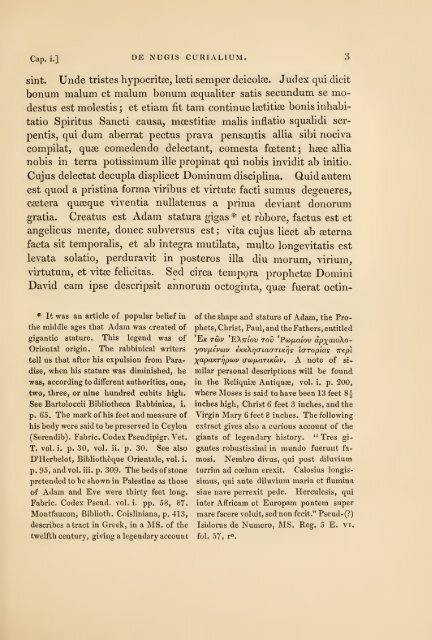Gualteri Mapes. De nugis curialium distinctiones quinque
Gualteri Mapes. De nugis curialium distinctiones quinque
Gualteri Mapes. De nugis curialium distinctiones quinque
You also want an ePaper? Increase the reach of your titles
YUMPU automatically turns print PDFs into web optimized ePapers that Google loves.
Cap. i.]<br />
DE NUGIS CURIALIUM.<br />
sint. Unde tristes hypocritse, laeti semper deicolse. Judex qui dicit<br />
bonum malum et malum bonum eequaliter satis secundum se mo-<br />
destus est molestis ; et etiam fit tam continue leetitiee bonis inhabi-<br />
tatio Spiritus Sancti causa, moestitiae raalis inflatio squalidi ser-<br />
pentis, qui dum aberrat pectus prava pensantis allia sibi nociva<br />
compilat, quae comedendo delectant, comesta foetent ; hsec allia<br />
nobis in terra potissimum ille propinat qui nobis invidit ab initio.<br />
Cujus delectat decupla displicet Dominum disciplina. Quid autem<br />
est quod a pristina forma viribus et virtute facti sumus degeneres,<br />
csetera queeque viventia nullatenus a prima deviant donorum<br />
gratia. Creatus est Adam statura gigas * et robore, factus est et<br />
angelicus mente, donee subversus est; vita cujus licet ab eeterna<br />
facta sit temporalis, et ab Integra mutilata, multo longevitatis est<br />
levata solatio, perduravit in posteros ilia diu morum, virium,<br />
virtutum, et vitee felicitas. Sed circa tempora prophetee Domini<br />
David earn ipse descripsit annorum octoginta, quae fuerat octin-<br />
* It was an article of popular belief in<br />
the middle ages that Adam was created of<br />
gigantic stature. This legend was of<br />
Oriental origin. The rabbinical writers<br />
tell us that after his expulsion from Para-<br />
dise, when his stature was diminished, he<br />
was, according to different authorities, one,<br />
two, three, or nine hundred cubits high.<br />
See Bartoloccii Bibliotheca Rabbinica, i.<br />
p. 65. The mark of his feet and measure of<br />
his body were said to be preserved in Ceylon<br />
(Serendib). Fabric. Codex Pseudipigr. Vet.<br />
T. vol. i. p. 30, vol. ii. p. 30. See also<br />
D'Herbelot, Biblioth^que Orientale, vol. i.<br />
p. 95, and vol. iii. p. 309. The beds of stone<br />
pretended to be shown in Palestine as those<br />
of Adam and Eve were thirty feet long.<br />
Fabric. Codex Pseud, vol. i. pp. 58, 87.<br />
Montfaucon, Biblioth. Coisliniana, p. 413,<br />
describes a tract in Greek, in a MS. of the<br />
twelfth century, giving a legendary account<br />
of the shape and stature of Adam, the Pro-<br />
phets, Christ, Paul, and the Fathers, entitled<br />
E/c tS)v 'EXttiou rov 'Pcojiaiov dp)(^aio\oyov^evav<br />
€KK\r]a-ia(rTiKfjs laTopias Trept<br />
XapaKTrjpcov ampaTLKOiv, A note of si-<br />
milar personal descriptions will be found<br />
in the Reliquige Antiquse, vol. i. p. 200,<br />
where Moses is said to have been 13 feet 8^<br />
inches high, Christ 6 feet 3 inches, and the<br />
Virgin Mary 6 feet 8 inches. The following<br />
extract gives also a curious account of the<br />
giants of legendary history. " Tres gi-<br />
gantes robustissimi in mundo fuerunt fa-<br />
mosi, Nembro divus, qui post diluvium<br />
turrim ad coelum erexit. Calosius longis-<br />
simus, qui ante diluvium maria et flumina<br />
sine nave perrexit pede. Herculesis, qui<br />
inter AfFricam et Europam pontem super<br />
mare facere voluit, sed non fecit." Pseud-(?)<br />
Isidorus de Numero, MS. Reg. 5 E. vi.<br />
fol. 57, r".

















